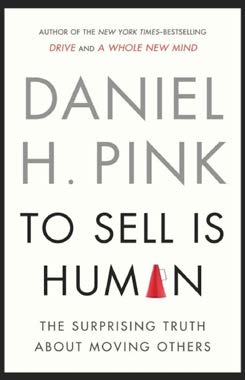It’s a mad, mad, digital world, says motivation maven Dan Pink — but you’d be ‘woefully mistaken’ to announce the death of the salesman.
Reviewed by Allan Fallow

Daniel Pink’s latest exercise in clear thinking is the essential read for salespeople, from naïve newbies to jaded veterans. He’s all about simplifying your sales message, so let me simplify his: “The capacity to sell isn’t some unnatural adaptation to the merciless world of commerce. It is part of who we are.”
That’s some highfalutin language, but Pink harbors no delusions about how society looks on sales: “Think of all the movies, plays and television programs that depict salespeople as one part greedy conniver, another part lunkheaded loser.” Yet that’s a laughably dated caricature, Pink observes, because more and more of us are being called upon to hone our powers of persuasion. In a 9,000-respondent survey commissioned by Pink, he discovered that people now spend “about 40 percent of their time at work engaged in non-sales selling — persuading, influencing and convincing others in ways that don’t involve anyone making a purchase.”
Even when you discount the influx of homegrown entrepreneurs brought about by websites such as Etsy (where 875,000 online shops sell more than $400 million of goods annually) and Kickstarter (where 1.8 million people have funded 20,000 projects to the tune of $200 million since 2009), traditional sales jobs are alive and thriving: 1 out of every 9 Americans makes his or her living “by trying to convince someone else to make a purchase.” And according to predictions from the Bureau of Labor Statistics, the U.S. will add nearly 2 million new sales jobs in the next six years alone. So the time seems ripe for this thoughtful analysis of the deeper forces motivating the purpose-driven salesperson (my phrase): “To sell well,” writes Pink, “is to convince someone else to part with resources — not to deprive that person, but to leave him better off in the end.”
Get Your Act Together
I could happily blather on about Pink’s sprightly diagnoses of social trends. (Especially keen are his takes on the growing elasticity of job skills and the declining “information asymmetry” in modern sales transactions.) But that would sell short the book’s extreme practicality. For example, have you ever considered taking a class in improvisational theater as a way to sharpen your interactions with buyers and sellers? In a selling environment that no longer prizes “overcoming objections” or “turning [reluctant] customers around,” Pink suggests, that’s not such a farfetched idea. Indeed, Pink quotes New Zealand scholar Zazli Wisker: Salespeople who become adept at improv “can generate ideas, incorporate changes quickly and easily, and communicate effectively and convincingly during sales presentations.”
Oh, and could your listening skills use a brush-up? If you’re like most of us, you’ve become adept at appearing to listen when what you’re really doing is waiting — that is, thinking about what you’re going to say once the speaker shuts up. Think how your client interactions might improve if you trained yourself to listen without listening for anything: “Once we listen in this new, more intimate way,” writes Pink, “we begin hearing things we might have missed. And if we listen this way during our efforts to move others, we quickly realize that what seem outwardly like objections are often offers in disguise.”
Make a Pitch
Equally useful to REALTORS® will be Pink’s discussion of “the six successors to the elevator pitch”:
The one-word pitch. The ultimate come-on for our attention-deprived era, says the author, “begins with a single word — and doesn’t go any further.” Hear the word “search” and you likely think of Google; hear “priceless” and MasterCard comes to mind. What’s your one-word equity?
The question pitch. If you learned that question pitches make people likelier to act on their beliefs, how fast could you capture a value proposition in the form of a query?
The rhyming pitch. A proposal rendered in verse improves the “processing fluency” of those who hear it, says social scientist Pink. It may take time, but a rhyme is sublime.
The subject-line pitch. People are likeliest to open emails that promise to 1) be useful or 2) satisfy the recipient’s curiosity.
So learn to encapsulate your pitch in a subject line that does one of those two things: For example: “4 tips to improve your golf swing this afternoon,” or “Some weird things I just learned about email.”
The “twitpitch.” A great way to hone your spiel is to reduce it to a micro-message of tweet length: 140 characters (including spaces) or fewer. As a bonus, consider teeing it up in what Pink calls an “experience frame”: “It’s not just the soft Corinthian leather — the Cordoba lets you see new places, visit old friends and add to your life’s trove of memories.”
The Pixar pitch. This format invites you to package your appeal in the same six-sentence format that can be used to summarize any feature film (such as Finding Nemo) produced by Pixar Animation Studios:
“Once upon a time, ___________.
Every day, ___________.
One day, ___________.
Because of that, ___________.
And because of that, ___________.
Until finally, ___________.”
I’ll spare you the Pixar pitch for To Sell Is Human, which Pink includes in its entirety. But you won’t be surprised to learn that it ends this way: “Until finally we learned that selling isn’t some grim accommodation to a brutal marketplace culture. It’s part of who we are — and therefore something we can do better by being more human.”








